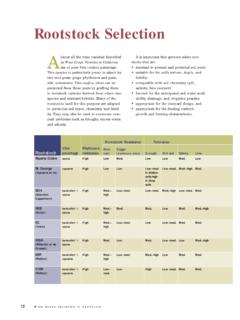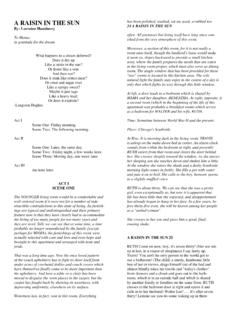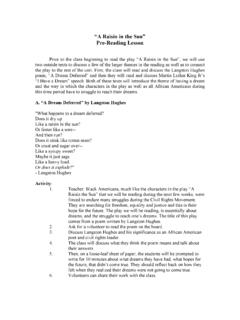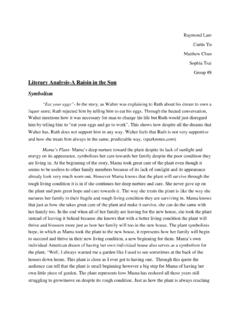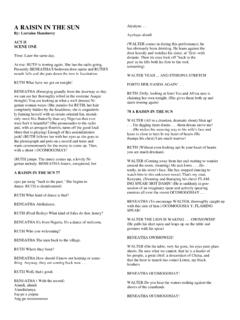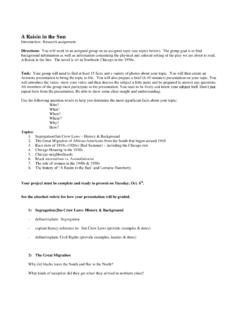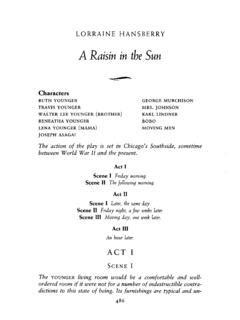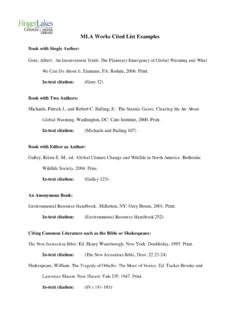Transcription of 2 0 27
1 207. 27. The Raisin Drying Process L . P e t e r C h r i s t e n s e n a n d W i ll i a m L . P e a c o c k Principles of Fruit Dehydration surface. The transfer rate is governed by differences between the vapor pressure of the fruit and that of the The outer layers and surface of grape berries have surrounding air, referred to as vapor pressure deficit or physical and chemical mechanisms to resist water evaporative potential. Vapor pressure deficits are great- loss nature's way of keeping the berry hydrated and est with a high berry temperature and a low relative turgid. The principal barrier is the berry cuticle, which humidity. High air temperatures and rapid air move- includes the outer layer of epicuticular wax or bloom. ment contribute to low relative humidities. Of these This wax consists of partially overlapping flat platelets factors, berry temperature is the most important driv- that are irregular or lacelike in texture (Figure ).
2 Ing force in field drying. Their orderly spacing and arrangement and the chemi- cal characteristics of the wax provide water repellence and vapor loss resistance. During drying, water in the grape berry moves Varietal Differences in Drying in the liquid phase through the cells to the cuticle. It must then pass as vapor through the wax platelets The length of time raisins take to dry is governed by and evaporate from the outside surface (Figure ). the physical characteristics of the grapes as well as Water movement within the grape is speedy in compar- environmental conditions. Studies have demonstrated ison to the slow transfer of water through the cuticle. that larger berries and thicker fruit skin both increase The rate of water loss from the berry is dependent on the drying time. This explains the differences between the water's rate of transfer and availability at the berry Zante Currant' ( Black Corinth'), Thompson Seed- Figure Scanning electron micrograph of the Thompson Seed- Figure Scanning electron micrograph of a fracture through a less' berry surface showing the typical arrangement and appearance frozen hydrated cuticle and epidermis of a Thompson Seedless' berry.
3 Of the cuticular wax platelets. Courtesy of Dr. Birgit Uhlig. The upper white layer is the epicuticular wax that is underlain by the cuticle and the cells with their wall structures. Courtesy of Dr. Birgit Uhlig. 208 H a rv e s t i n g and D ry i n g R a i s i n G r a p e s less,' and Muscat of Alexandria,' which rank from low 100. to high in drying time, berry size, and skin thickness. maximum Typically, Zante Currant' ( Black Corinth'), Thomp- 90. son Seedless,' and Muscat of Alexandria' naturally sun Temperature ( F). dry in 7 to 10, 14 to 21, and 24 to 30 days, respec- 80. tively. Drying time for Thompson Seedless' is longer when berries are enlarged through the use of gibber- 70. ellic acid (GA) or by other means. Dehydrator stud- minimum ies with undipped fruit demonstrated drying times of 60.
4 60 hours for Muscat of Alexandria' and 41 hours for Thompson Seedless.' This difference was calculated to 50. be almost exactly inverse to the grapes' difference in 20 25 30 4 9 14 19 24 29 4 9. surface area. August September October There are also differences among varieties of simi- Figure Normal (historical average) maximum and minimum lar berry size. For example, Fiesta' dries more quickly temperatures during the raisin drying period, Fresno Air Teminal, U. S. than Thompson Seedless.' This was demonstrated in Dept. of Commerce National Weather Service a 1995 replicated trial where Fiesta' and Thompson Seedless' were harvested on September 1 at the same 160. soluble solids content (approximately Brix) and Day 1. berry on top of tray tray-dried to similar moisture contents. Fiesta' dried 140.
5 To percent moisture when rolled on September 120. 21, while Thompson Seedless' was at percent moisture on September 25. Drying temperatures were 100. normal during this 4-day period of difference. These berry on bottom of tray data suggest that varietal differences in berry skin and 80. cuticle characteristics also influence fruit drying rate. 60 ambient temperature 40. 160. Day 7. Temperature Conditions during Field 140 berry on top of tray Drying 120. The normal (historical) average daily maximum and Temperature ( F). minimum temperatures recorded by the National 100. Weather Service Station in Fresno during the raisin berry on bottom of tray 80. drying period are given in Figure It shows the steady decline in average temperatures, equivalent to 60 ambient temperature 1 F (approximately C) about every 4 days, from mid-August to mid-October.
6 Obviously, grapes har- 40. 160. vested in mid-August are exposed to higher tempera- Day 14. tures than grapes harvested several weeks later. Shorter 140 berry on top of tray days and lower sun angles also contribute to slowed drying later in the season. As a result, grapes harvested 120. on August 25 typically dry within 2 weeks while those 100. harvested 10 days later will take 21 2 to 3 weeks. 80 berry on bottom of tray Tray Drying Temperatures 60. ambient temperature Official weather reports give temperature readings 40. from sheltered thermometers that represent ambient 1 3 5 7 9 11 13 15 17 19 21 23. air temperatures. Temperatures on the raisin-drying Time (hr). trays, however, get much hotter. Representative tray temperatures during three different days of drying Figure Raisin tray temperatures ( F) during days 1, 7, and 14.
7 After harvest; hourly readings for 24-hour periods. Comparison of top are depicted in Figure The values show diurnal and bottom berries on a tray with ambient temperature at a 5-foot changes in berry temperature in the first, seventh, and ( m) height. Kearney Agricultural Center, 1994. fourteenth days of drying. In this study conducted C h a p t e r 27: T h e R a i s i n D ry i n g P r o c e s s 209. 100. at the University of California's Kearney Agricultural Center in Parlier, temperatures were recorded every End of row hour as ambient in the row middle at a 5-foot ( m) In-row 25 feet 90. In-row 50 feet height and in berries on trays. Temperature probes were placed in berries at the top and bottom of the clusters Temperature ( F). on the trays. On day 1 maximum ambient temperature 80. reached 87 F ( C) in midafternoon, while berries on the top of the tray reached a peak of 136 F ( C).
8 Several hours earlier. Berries on the bottom of the tray 70. reached their peak temperature of 122 F ( C) 3. hours after the top berries. The more exposed top ber- ries cooled more quickly in the evening and dropped 60. to ambient temperature by early morning. Day 7 was hotter, reaching 95 F ( C) ambient temperature and 143 F ( C) in the top berries. Initial differ- 50. ences between the top and bottom berries diminished 100. due to the lower moisture content of the fruit. On day 14 the differences between the top and bottom berries 90. were quite small, both day and night, due to their more 80. similar exposure and moisture content. These high drying temperatures are achieved by the 70. Relative Humidity (%). absorption of radiant sunlight and heat accumulation at 60. the soil and fruit surfaces during the day.
9 The rise in tem- perature of berries on the top of the tray begins abrupt- 50. ly between 8:30 and 9:00 am, rises rapidly until 12:00. 40. noon, peaks about 3:00 pm, and then declines to near ambient temperature at about midnight. Berry tempera- 30. tures above 150 F ( C) have been recorded in other 20. studies when ambient temperatures have reached 106 F. ( C). Such temperatures can contribute to sugar car- 10. amelization as discussed later in this chapter. 0. 1 3 5 7 9 11 13 15 17 19 21 23. In-Row Distance Effects Time (hr). Raisin trays placed at the row ends dry more slowly Figure Ambient air temperatures ( F) and relative humidities (%) at a 5-foot ( m) height during raisin drying. Comparison of dis- that those farther down the row. This is because the tances of 0, 25, and 50 feet (0, , and 15 m) down a vineyard row.
10 Row canopies reduce air circulation, increasing both hourly readings over 24 hours. Kearney Agricultural Center, 1994. air temperature and humidity. The progressive increase in air temperature from the row ends toward the inte- rior has been characterized in raisin drying studies as the vine rows hastened raisin drying even though rela- shown in Figure It shows that ambient air tem- tive humidities were higher. peratures and humidities increase with distance down the row beginning at about 10 am . The differences reach a maximum from about 3 to 5 pm. The differing rates of drying at these distances Raisin Tray Characteristics down the row are shown in Figure It the study, the end trays always lagged behind those that dried at Tray Filling the higher temperatures 25 and 50 feet ( and 15 m).
